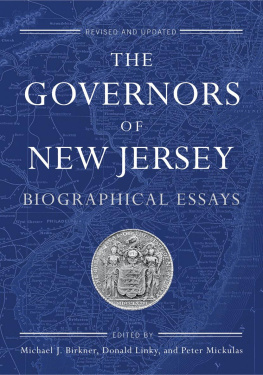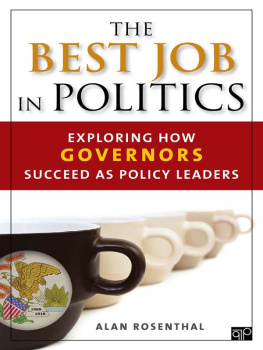Rivergate Regionals
Rivergate Regionals is a collection of books published by Rutgers University Press focusing on New Jersey and the surrounding area. Since its founding in 1936, Rutgers University Press has been devoted to serving the people of New Jersey and this collection solidifies that tradition. The books in the Rivergate Regionals Collection explore history, politics, nature and the environment, recreation, sports, health and medicine, and the arts. By incorporating the collection within the larger Rutgers University Press editorial program, the Rivergate Regionals Collection enhances our commitment to publishing the best books about our great state and the surrounding region.
The Governors of New Jersey
Biographical Essays
Edited by
Michael J. Birkner, Donald Linky, and Peter Mickulas
Rutgers University Press
New Brunswick, New Jersey, and London
Library of Congress Cataloging-in-Publication Data
The governors of New Jersey : biographical essays / edited by Michael J.
Birkner, Donald Linky, and Peter Mickulas. Second edition.
pages cm. (Rivergate regionals)
Revised edition of: The governors of New Jersey, 1664 1974 :
biographical essays / edited by Paul A. Stellhorn, Michael J. Birkner.
Trenton : New Jersey Historical Commission, 1982.
Includes bibliographical references and index.
ISBN 978-0-8135-6244-5 (hardcover : alk. paper)
ISBN 978-0-8135-6245-2 (e-book)
1. Governors New Jersey Biography. 2. New Jersey Politics and
government. I. Birkner, Michael J., 1950 II. Linky, Donald. III. Mickulas,
Peter, 1968
F133.G68 2014
974.9'00922 dc23....2013013409
[B]
A British Cataloging-in-Publication record for this book is available from the British Library.
This collection 2014 by the New Jersey Historical Commission; individual essays for the second edition copyright 2014 in the names of their authors.
All rights reserved
No part of this book may be reproduced or utilized in any form or by any means, electronic or mechanical, or by any information storage and retrieval system, without written permission from the publisher. Please contact Rutgers University Press, 106 Somerset Street, New Brunswick, NJ 08901. The only exception to this prohibition is fair use as defined by U.S. copyright law.
Visit our website: http://rutgerspress.rutgers.edu
Manufactured in the United States of America
Erratum: Citations in bibliographies to the New Jersey State Library, or the New Jersey State Library, Bureau of Archives and History, should be to the New Jersey State Archives, Trenton.
Dedicated to the memory of Paul A. Stellhorn and Alan Rosenthal
and to the citizens of New Jersey
Contents
Edmund Andros (East and West New Jersey,
1674 81, 1688 89)
Andrew Hamilton (East and West New Jersey,
1692 98, 1699 1703)
Jeremiah Basse (East and West New Jersey,
1698 99)
A. Harry Moore (1926 29, 1932 35,
1938 41)
Alphabetical List of Governors
Illustrations
Preface
In a version of rich man, poor man, beggar man, thief, the governors office in New Jersey has been inhabited since its inception in 1664 by a wide range of characters who for good or ill stamped their influence on the states polity. In this New Jersey has probably differed more in degree than substance from its neighbors, indeed, from any other state. What makes New Jersey distinctive are the different constitutional arrangements that helped or hindered its governors attempts to influence policymaking and to leave a positive legacy for the future. Writing for the tercentenary celebration of New Jerseys history, Duane Lockard reminded readers in his The New Jersey Governor: A Study of Political Power that even under weak constitutions a strong leader could exert influence; and even under a strong governor constitution (New Jersey has one of the strongest of all the states), a weakling can fail.
Eighteen years after Lockard produced what is still the best single-volume treatment of the governorship, Paul Stellhorn and Michael Birkner published a set of essays treating each governor who served between the colonys founding in 1664 and the close of William P. Cahills one-term governorship in 1973. The essays in that volume collectively reinforced Lockards central argument, while adding a great measure of amplifying detail. New Jersey has a strong governor system, but governors who have served since 1964 have demonstrated varying degrees of political vision and sagacity.
There are two major premises behind the decision to publish this revised and expanded edition of The Governors of New Jersey . First, and perhaps foremost, we wanted to introduce New Jerseyans to the governors and acting governors who have served the state since the 1974. They are a mixed lot. Each governor made decisions that have had consequences beyond his or her term of office, yet there has been relatively little analysis of the administrations of these governors. Second, a new edition offers the opportunity to bring the governorship of New Jersey to a new audience. While most of the original essays have been only modestly revised to bring the scholarly literature on a particular governor up to date, in at least one instance a fundamental rewriting of an essay was called for, due to a recent revisionist interpretation of one of the states most controversial governors, Lord Cornbury. Discerning readers of this edition will notice that we continue to run the original illustration that was widely viewed as Cornbury in womens clothing, but this time with the cautionary note that the illustration is much disputed.
No essay or portrait is as much contested as Cornburys, but the essays herein will provide ample material for ongoing research on and evaluation of the individuals herein depicted. History is an argument without end. To have a good argument you need good material to work with. We hope this volume provides just that for the next generation of governor watchers.
Michael J. Birkner
Donald Linky
Peter Mickulas
Acknowledgments
The editors of the new edition would like to thank, at the New Jersey Historical Commission, Sara Cureton, Marc Mappen, Skylar Harris, and Niquole Primiani; at the New Jersey State Archives, Joanne Nestor, Veronica Calder, and Joseph Klett; and at the New Jersey State Library, Deborah Mercer. We are grateful, too, to the authors of the new essays for contributing their expertise on the states most recent governors. We thank also those authors from the original edition who offered suggestions for updating their essays and provided new biographical information. Thanks, too, go to the staff at Rutgers University Press, especially Marlie Wasserman, Marilyn Campbell, Allyson Fields, Andrew Katz, Anne Hegeman, and Bryce Schimanski. Special appreciation to Joy Stoffers for her intrepid research on images.
Michael J. Birkner
Donald Linky
Peter Mickulas
The Governors of New Jersey
Introduction
The role of the governor of New Jersey has shrunk, then grown as the men (and, to date, one woman) of successive eras have applied new ideas about what good government is and how to provide it. Under different systems men with different abilities and motives have been chosen for the office, and different kinds of leadership have been expected of them. In the long run, however, the variations are relatively unimportant. The history of the office divides into four periods. In colonial times the governor was the agent of autocratic, external power. Under the constitution of 1776 he was meant to be a figurehead with little official responsibility. His scope increased under the constitution of 1844, but the legislative branch remained stronger than the executive. Under the constitution of 1947 the governor gained new tools and opportunities for the exercise of vigorous leadership.









